Digital Twin Haptic Robotic Arms: Towards Handshakes in the Metaverse
Abstract
:1. Introduction
2. Related Work
3. Methodology
- Sensing Module: This module is activated as soon as the system is powered on. The main duty performed by this module is sensing the raw sensory data from the Real Twin while in contact with the Robo Twin hand, performing a handshake. All the raw signals received by the sensors are then sent to the processing module, where they are converted to their corresponding physical values by the controller.
- Processing Module: This module performs the processing of the received raw analog signals from the sensors by converting them into meaningful interpreted physical data. It also actuates the actuators upon receiving the processed data from the other Robo Twin’s processing module. Additionally, more importantly, upon receiving any nonzero signal from the force sensors located on the Robo Twin’s hand, it then generates the control signals for the inward grasp of the subject’s hand. These control signals actuate the servo motors of each finger of the Robo Twin’s hand to grasp the subject’s hand for a handshake. When the subject withdraws contact from the located force sensors on the Robo Twin’s hand, it then generates the control signals for the outward grasp motion of the Robo Twin’s fingers, thereby releasing the user’s hand and ending the handshake.While performing all the above-mentioned tasks, this processing module simultaneously sends the processed sensory data to the data-collecting and data-transmitting and -receiving modules for real-time recording and transmission.
- Data-Collecting Module: This part of the system’s architecture is responsible for the real-time recording of the sensory data while Robo Twin is performing a handshake with the user. This module is triggered by the output of the processing module, i.e., as soon as the interpreted physical data are made available.
- Data-Transmitting and -Receiving Module: This module establishes communication between the two Robo Twin arms for simultaneous and bidirectional transfer of sensory data.
4. Design of Robo Twin Arm
4.1. Robo Twin’s Arm Structure
4.2. Sensor and Actuator Placement
5. Implementation
5.1. Force Sensors
5.2. Temperature Sensors
5.3. Vibrotactile Force Actuators
6. Performance Evaluation
6.1. Experimental Objective
6.2. Experimental Setup
6.3. Experimental Results
6.3.1. Qualitative Analysis
6.3.2. Quantitative Analysis
- Duration of handshake (in seconds): The participants were told to begin a handshake with a standard grasp, comparable to how they would normally interact with others daily, and then progressively tighten the grip. This deliberate fluctuation in grip strength allowed users to observe how the robotic system gradually changed the amount of force it applied in response to the force that was perceived during the handshake. The length of the handshake that was recorded corresponds to the beginning and end of the specified handshake. On an average, the duration of the handshake for females was ‘7.88 s’, whereas for male participants, it was ‘11.03 s’, being approximately ‘3 s’ longer than that of the female participants. The results obtained are in accordance with the study [41], which found that males tended to have a longer duration of handshakes than their female counterparts. The average duration of handshakes for both males and females is illustrated in Figure 12a.
- Average force applied (in Newtons): The average force applied by each participant while performing a handshake is the average value sensed by all force sensors placed on the Robo Twin hand over the duration of the participant’s handshake. By averaging the values of force applied by individual male and female participants, we found that males tended to apply comparatively more force than their female counterparts, in conformity with [41,42]. This difference in the average force applied by each gender during the duration of the handshake is illustrated in Figure 12b.
- Maximum force applied (in Newtons): The maximum applied force is the maximum value of force sensed by the FSR sensors placed on the hand during the entire course of the handshake by the participant. We found that the maximum force that a male candidate applied during the handshake with the Robo Twin hand was 10.08 N, while the maximum force that a female candidate applied was 5.97 N. Calculating the average of maximum applied force by gender, this average was 4.58 N for females, whereas it was 7.11 N for males. Hence, during the handshake, male participants tended to apply significantly more force than the female participants, as found in [42].Additionally, we observed that some of the male participants applied less force than some of the female participants. This is in accordance with the study [43], which measures the hand grip strength in young men, women and highly trained female athletes using a handheld hand grip ergometer instead of human-provided ratings, as in [41]. This study states that 5% of female participants applied more force than 10% of male participants. Therefore, not all males will have higher values of applied force than females, and not all females will have lesser values of applied force than males.
- Palm and thumb temperature (in °C): With the help of temperature sensors integrated on the Robo Twin hand, we were able to sense and record the average temperature of the participants’ palm and thumb for the duration of a handshake. We found that for both the average temperature of the palm or the thumb, the male participants’ temperature was maintained at a slightly higher value than the female participants’ temperature. Additionally, when comparing the temperature of the palm with the thumb, whether it is male or female participants, we noticed that the palms of the participants’ hands were maintained at a higher temperature than the thumbs. These details are illustrated in Figure 13.
- Personality and handshaking characteristics: The participants’ personality traits were assessed through a report generated by the ITP (Individual and Team Performance) metric platform based on the responses to the questionnaires that the participants completed. This report outlines the level of each participant’s five personality factors, namely extraversion, emotionality, conscientiousness, agreeableness, and openness. The score for each trait is presented in percentile form, with categories of ‘Low’ (between 0th and 25th percentile), ‘Moderate’ (between 25th and 75th percentile) and finally ‘High’ (more than 75th percentile).For the male participants, we found that those who applied the least force and had a short duration while performing a handshake scored high on conscientiousness and emotionality but low on the extroversion, agreeableness, and openness scales. Meanwhile, participants who applied the most force and had a longer duration scored high on conscientiousness, agreeableness, and openness, but moderately on the extraversion and emotionality scales. We represent these results with a four-quadrant plot with ‘Duration’ on the X-axis and ‘Average applied force’ on the Y-axis in Figure 14.For the female participants, we found that the participants with firmer handshakes were more open to the experience only if they scored high on conscientiousness, emotionality, agreeableness and low to moderately on the extraversion scale of personality traits. Meanwhile, the participants with less-firm handshakes were found to be less open to the experience, provided they scored low on conscientiousness and agreeableness, moderately on emotionality and low to moderately on the extraversion scale of personality traits.The results obtained are generally in conformity with [41,42], which showed that the individuals with longer and firmer handshakes were more open to the experience. However, we believe that to be able to comment more on the correlation between personality traits and handshake characteristics, a larger dataset is needed.
7. Limitations
8. Conclusions
Author Contributions
Funding
Institutional Review Board Statement
Informed Consent Statement
Data Availability Statement
Conflicts of Interest
References
- Yang, Q.; Zhao, Y.; Huang, H.; Xiong, Z.; Kang, J.; Zheng, Z. Fusing Blockchain and AI with Metaverse: A Survey. IEEE Open J. Comput. Soc. 2022, 3, 122–136. [Google Scholar] [CrossRef]
- Grieves, M.; Vickers, J. Digital Twin: Mitigating Unpredictable, Undesirable Emergent Behavior in Complex Systems. In Transdisciplinary Perspectives on Complex Systems; Springer International Publishing: Cham, Switzerland, 2017; pp. 85–113. [Google Scholar]
- El Saddik, A. Digital Twins: The Convergence of Multimedia Technologies. IEEE MultiMedia 2018, 25, 87–92. [Google Scholar] [CrossRef]
- Alam, K.M.; El Saddik, A. C2PS: A Digital Twin Architecture Reference Model for the Cloud-Based Cyber-Physical Systems. IEEE Access 2017, 5, 2050–2062. [Google Scholar] [CrossRef]
- El Saddik, A.; Badawi, H.F.; Martinez, R.; Laamarti, F.; Diaz, R.G.; Bagaria, N.; Arteaga-Falconi, J.S. Dtwins: A Digital Twins Ecosystem for Health and Well-Being. IEEE COMSOC MMTC Commun.-Front. 2019, 14, 39–43. [Google Scholar]
- Ferdousi, R.; Laamarti, F.; Hossain, M.A.; Yang, C.; El Saddik, A. Digital twins for well-being: An overview. Digit. Twin 2022, 1, 7. [Google Scholar] [CrossRef]
- Faisal, M.; Velazquez, R.A.M.; Laamarti, F.; El Saddik, A. Underactuated digital twin’s robotic hands with tactile sensing capabilities for well-being. In Digital Twin for Healthcare; Academic Press: Cambridge, MA, USA, 2023; pp. 15–38. [Google Scholar] [CrossRef]
- Salisbury, K. Plenary talks: Touching. In Proceedings of the 2016 IEEE Haptics Symposium, Philadelphia, PA, USA, 8–11 April 2016; p. xi. [Google Scholar] [CrossRef]
- Prasad, V.; Stock-Homburg, R.; Peters, J. Advances in Human-Robot Handshaking. In Proceedings of the 12th International Conference on Social Robots, ICSR 2020, Golden, CO, USA, 14–18 November 2020; Lecture Notes in Computer Science. Springer International Publishing: Cham, Switzerland, 2020; Volume 1, pp. 478–489. [Google Scholar]
- Prasad, V.; Stock-Homburg, R.; Peters, J. Human-Robot Handshaking: A Review. Int. J. Soc. Robot. 2022, 14, 277–293. [Google Scholar] [CrossRef]
- Melnyk, A.; Hénaff, P.; Popov, A. Analysis of a handshake between humans using wavelet transforms. In Proceedings of the 2015 IEEE 35th International Conference on Electronics and Nanotechnology, Kyiv, Ukraine, 21–24 April 2015; pp. 397–401. [Google Scholar] [CrossRef]
- Melnyk, A.A.; Borysenko, V.P.; Hénaff, P. Analysis of synchrony of a handshake between humans. In Proceedings of the 2014 IEEE/ASME International Conference on Advanced Intelligent Mechatronics, Besacon, France, 8–11 July 2014; pp. 1753–1758. [Google Scholar] [CrossRef] [Green Version]
- Capelle, E.; Benson, W.N.; Anderson, Z.; Weinberg, J.B.; Gorlewicz, J.L. Design and implementation of a haptic measurement glove to create realistic human-telerobot interactions. In Proceedings of the 2020 IEEE/RSJ International Conference on Intelligent Robots and Systems, Las Vegas, NV, USA, 24 October 2020–24 January 2021; pp. 9781–9788. [Google Scholar] [CrossRef]
- Melnyk, A.; Henaff, P. Bio-inspired plastic controller for a robot arm to shake hand with human. In Proceedings of the 2016 IEEE 36th International Conference on Electronics and Nanotechnology, Kyiv, Ukraine, 19–21 April 2016; Volume 180, pp. 163–168. [Google Scholar] [CrossRef]
- Park, S.; Lee, H.; Hanson, D.; Oh, P.Y. Sophia-Hubo’s Arm Motion Generation for a Handshake and Gestures. In Proceedings of the 2018 15th International Conference on Ubiquitous Robots (UR), Honolulu, HI, USA, 26–30 June 2018; pp. 511–515. [Google Scholar] [CrossRef]
- Cabibihan, J.J.; El-Noamany, A.; Ragab, A.M.; Ang, M.H. Guidelines for Robot-to-Human Handshake from the Movement Nuances in Human-to-Human Handshake. Front. Robot. AI 2022, 9, 758519. [Google Scholar] [CrossRef] [PubMed]
- Arns, M.; Laliberte, T.; Gosselin, C. Design, control and experimental validation of a haptic robotic hand performing human-robot handshake with human-like agility. In Proceedings of the 2017 IEEE/RSJ International Conference on Intelligent Robots and Systems (IROS), Vancouver, BC, Canada, 24–28 September 2017; pp. 4626–4633. [Google Scholar] [CrossRef]
- Beaudoin, J.; Laliberte, T.; Gosselin, C. Haptic Interface for Handshake Emulation. IEEE Robot. Autom. Lett. 2019, 4, 4124–4130. [Google Scholar] [CrossRef]
- Ammi, M.; Demulier, V.; Caillou, S.; Gaffary, Y.; Tsalamlal, Y.; Martin, J.-C.; Tapus, A. Haptic Human-Robot Affective Interaction in a Handshaking Social Protocol. In Proceedings of the 2015 10th ACM/IEEE International Conference on Human-Robot Interaction (HRI), Portland, OR, USA, 2–5 March 2015; pp. 263–270. [Google Scholar] [CrossRef]
- Vigni, F.; Knoop, E.; Prattichizzo, D.; Malvezzi, M. The Role of Closed-Loop Hand Control in Handshaking Interactions. IEEE Robot. Autom. Lett. 2019, 4, 878–885. [Google Scholar] [CrossRef]
- Nenchev, D.N.; Konno, A.; Tsujita, T. Introduction. In Humanoid Robots; Butterworth-Heinemann Publications: Oxford, UK, 2019; pp. 1–14. [Google Scholar] [CrossRef]
- ASIMO by Honda|The World’s Most Advanced Humanoid Robot. Available online: https://asimo.honda.com/asimo-specs/ (accessed on 24 April 2022).
- Honda Debuts New Humanoid Robot ‘ASIMO’; Honda Motor Co., Ltd.: Tokyo, Japan, 2001; Volume 28. [CrossRef]
- Kaneko, K.; Kanehiro, F.; Kajita, S.; Yokoyama, K.; Akachi, K.; Kawasaki, T.; Ota, S.; Isozumi, T. Design of prototype humanoid robotics platform for HRP. In Proceedings of the IEEE/RSJ International Conference on Intelligent Robots and Systems, Lausanne, Switzerland, 30 September–4 October 2002; Volume 3, pp. 2431–2436. [Google Scholar] [CrossRef]
- Kaneko, K.; Kanehiro, F.; Kajita, S.; Hirukawa, H.; Kawasaki, T.; Hirata, M.; Akachi, K.; Isozumi, T. Humanoid robot HRP-2. In Proceedings of the IEEE International Conference on Robotics and Automation, New Orleans, LA, USA, 26 April–1 May 2004; Volume 2, pp. 1083–1090. [Google Scholar] [CrossRef]
- Kaneko, K.; Harada, K.; Kanehiro, F.; Miyamori, G.; Akachi, K. Humanoid robot HRP-3. In Proceedings of the 2008 IEEE/RSJ International Conference on Intelligent Robots and Systems, Nice, France, 22–26 September 2008; pp. 2471–2478. [Google Scholar] [CrossRef]
- Topio—Robotic Infrastructure & Services Provider Robot Center. Available online: https://www.robotcenter.co.uk/products/humanoid-robot-hrp-4?variant=187380732 (accessed on 14 December 2021).
- Fujitsu Introduces Miniature Humanoid Robot, HOAP-1. Available online: https://pr.fujitsu.com/en/news/2001/09/10.html (accessed on 14 December 2021).
- Gouaillier, D.; Hugel, V.; Blazevic, P.; Kilner, C.; Monceaux, J.; Lafourcade, P.; Marnier, B.; Serre, J.; Maisonnier, B. Mechatronic design of NAO humanoid. In Proceedings of the 2009 IEEE International Conference on Robotics and Automation, Kobe, Japan, 12–17 May 2009; pp. 769–774. [Google Scholar] [CrossRef]
- Pepper and NAO in the Service of the Healthcare Sector|SoftBank Robotics EMEA. Available online: https://www.softbankrobotics.com/emea/en/pepper-and-nao-robots-education (accessed on 4 July 2021).
- Wu, L.; Larkin, M.; Potnuru, A.; Tadesse, Y. HBS-1: A modular child-size 3D printed humanoid. Robotics 2016, 5, 1. [Google Scholar] [CrossRef] [Green Version]
- Tian, L.; Thalmann, N.M.; Zheng, J.; Thalmann, D. Design of a Highly Biomimetic and Fully-Actuated Robotic Finger. In Proceedings of the 2019 IEEE Symposium Series on Computational Intelligence (SSCI), Xiamen, China, 6–9 December 2019; pp. 2382–2387. [Google Scholar] [CrossRef]
- Shorthose, O.; Albini, A.; He, L.; Maiolino, P. Design of a 3D-Printed Soft Robotic Hand with Integrated Distributed Tactile Sensing. IEEE Robot. Autom. Lett. 2022, 7, 3945–3952. [Google Scholar] [CrossRef]
- Ntagios, M.; Nassar, H.; Pullanchiyodan, A.; Navaraj, W.T.; Dahiya, R. Robotic Hands with Intrinsic Tactile Sensing via 3D Printed Soft Pressure Sensors. Adv. Intell. Syst. 2020, 2, 1900080. [Google Scholar] [CrossRef] [Green Version]
- Kappassov, Z.; Khassanov, Y.; Saudabayev, A.; Shintemirov, A.; Varol, H.A. Semi-anthropomorphic 3D printed multigrasp hand for industrial and service robots. In Proceedings of the 2013 IEEE International Conference on Mechatronics and Automation, Takamatsu, Japan, 4–7 August 2013; pp. 1697–1702. [Google Scholar] [CrossRef]
- Li, S.; Rameshwar, R.; Votta, A.M.; Onal, C.D. Intuitive Control of a Robotic Arm and Hand System with Pneumatic Haptic Feedback. IEEE Robot. Autom. Lett. 2019, 4, 4424–4430. [Google Scholar] [CrossRef]
- Langevin, G. InMoov Open-Source 3D Printed Life-Size Robot. 2014. Available online: http://inmoov.fr. (accessed on 26 April 2022).
- Lanigan, D.; Tadesse, Y. Low Cost Robotic Hand that Senses Heat and Pressure. In Proceedings of the 2017 ASEE Gulf-Southwest Sectional Annual Conference, Richardson, TX, USA, 12–14 March 2017; Available online: https://personal.utdallas.edu/~ytt110030/data/ASEE_David.pdf (accessed on 27 April 2023).
- Salman, F.; Cui, Y.; Imran, Z.; Liu, F.; Wang, L.; Wu, W. A Wireless-controlled 3D printed Robotic Hand Motion System with Flex Force Sensors. Sens. Actuators A Phys. 2020, 309, 112004. [Google Scholar] [CrossRef]
- The BIG FIVE Personality Assessment. Available online: https://www.itpmetrics.com/ (accessed on 24 January 2023).
- Chaplin, W.F.; Phillips, J.B.; Brown, J.D.; Clanton, N.R.; Stein, J.L. Handshaking, gender, personality, and first impressions. J. Pers. Soc. Psychol. 2000, 79, 110–117. [Google Scholar] [CrossRef] [PubMed]
- Orefice, P.H.; Ammi, M.; Hafez, M.; Tapus, A. Let’s handshake and I’ll know who you are: Gender and personality discrimination in human-human and human-robot handshaking interaction. In Proceedings of the 2016 IEEE-RAS 16th International Conference on Humanoid Robots (Humanoids), Cancun, Mexico, 15–17 November 2016; pp. 958–965. [Google Scholar] [CrossRef]
- Leyk, D.; Gorges, W.; Ridder, D.; Wunderlich, M.; Rüther, T.; Sievert, A.; Essfeld, D. Hand-grip strength of young men, women and highly trained female athletes. Eur. J. Appl. Physiol. 2007, 99, 415–421. [Google Scholar] [CrossRef] [PubMed]
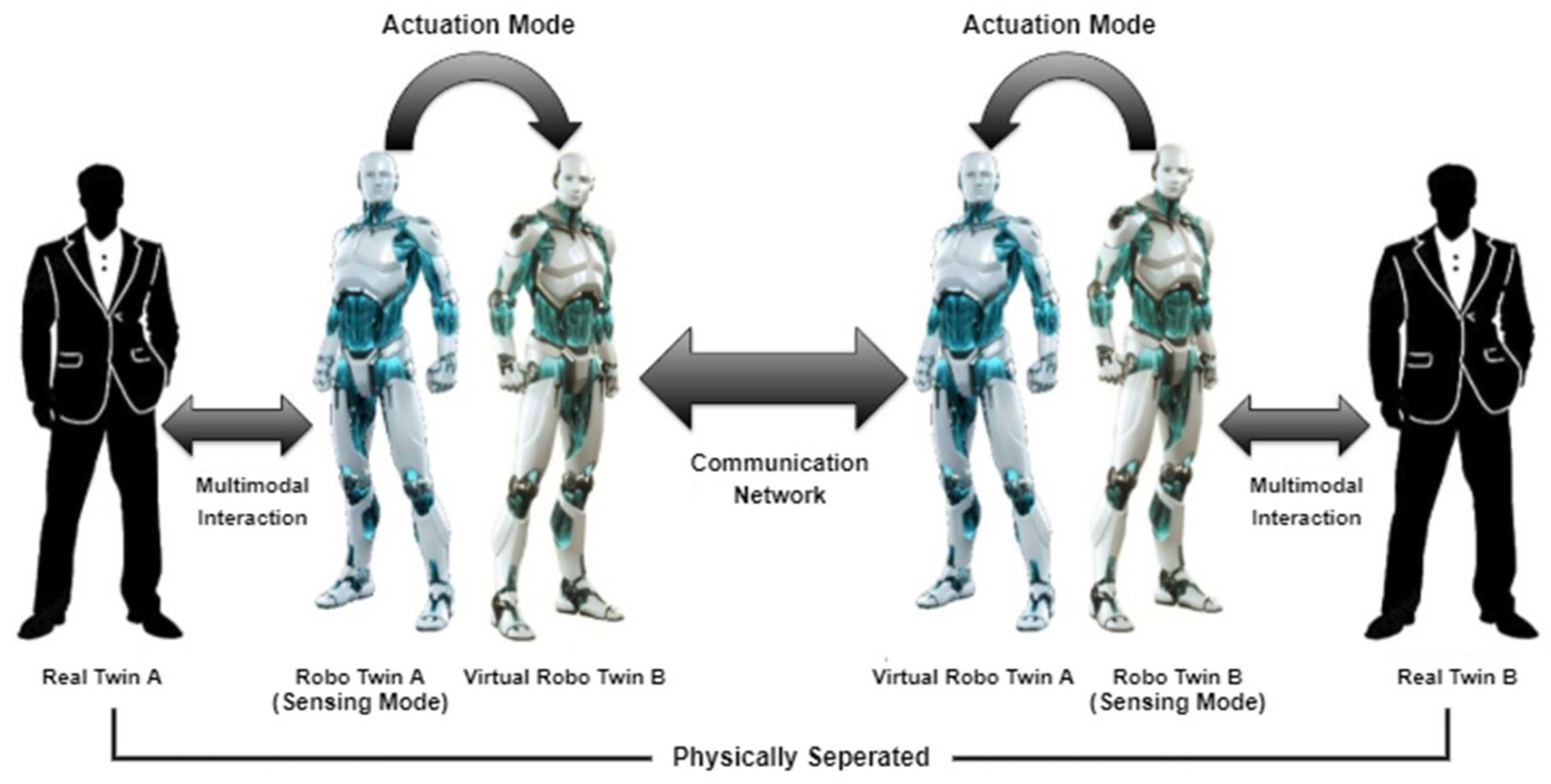

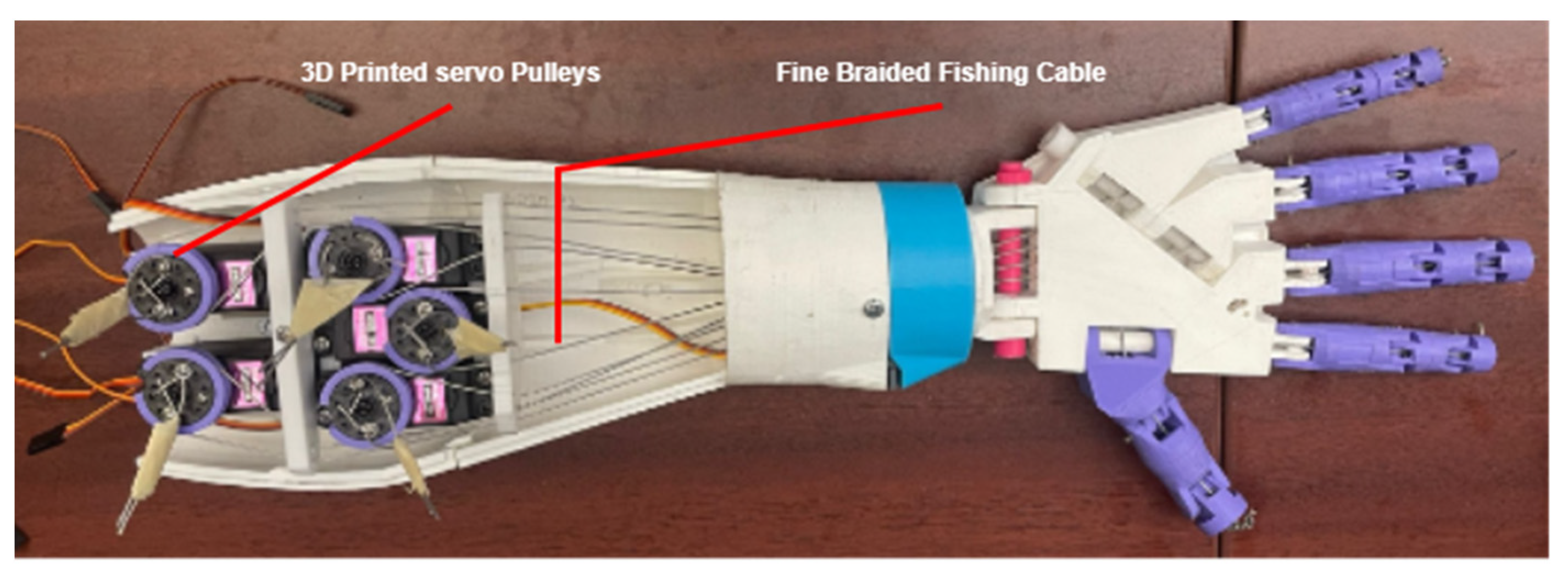
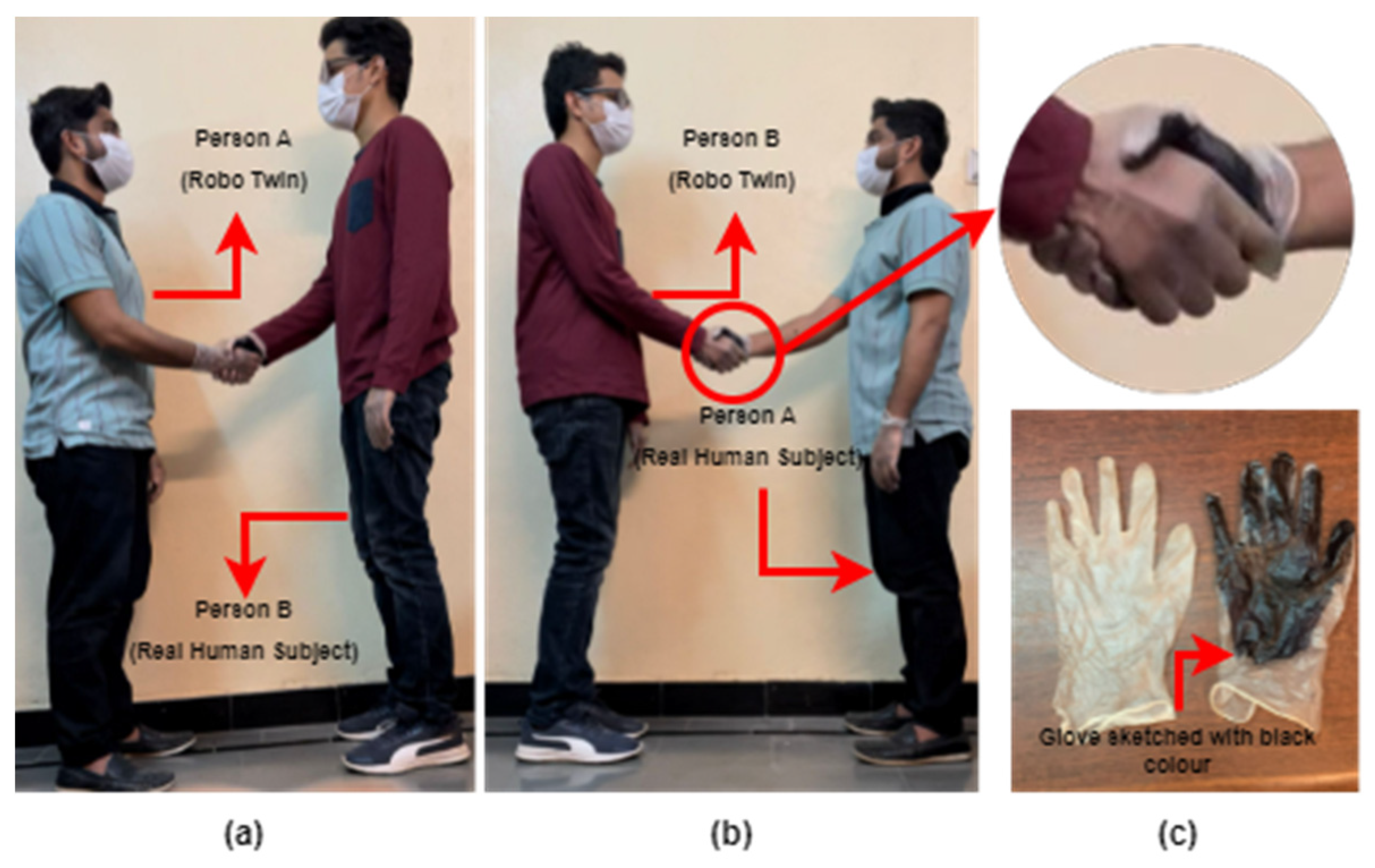
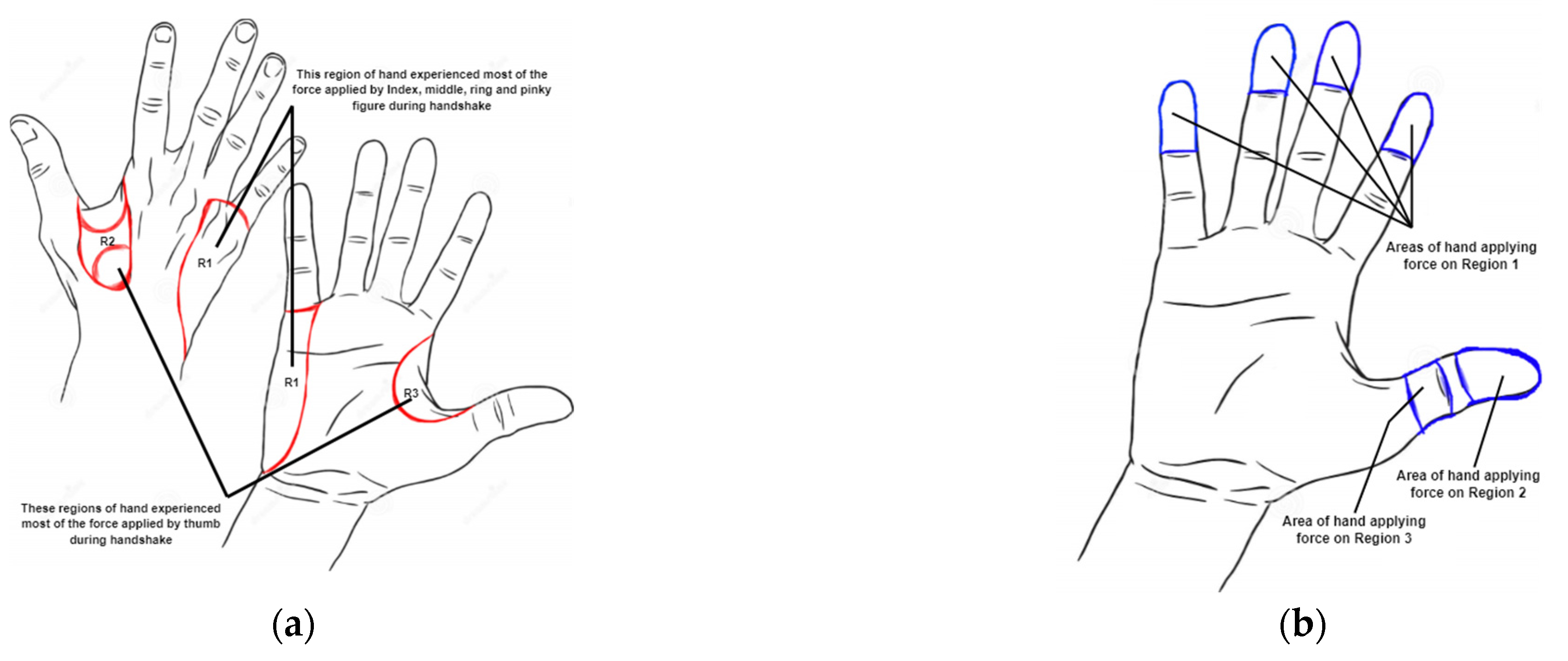
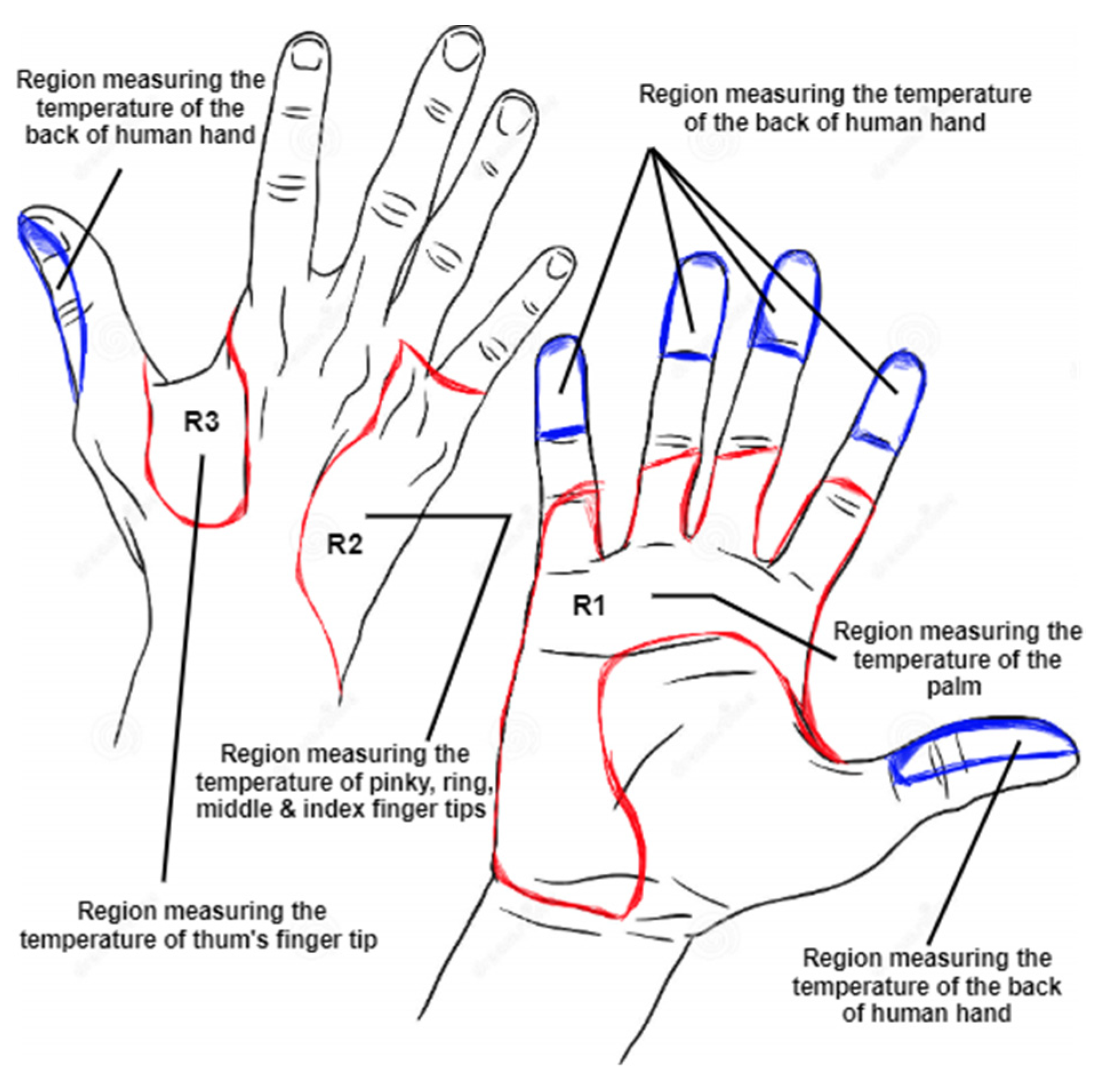


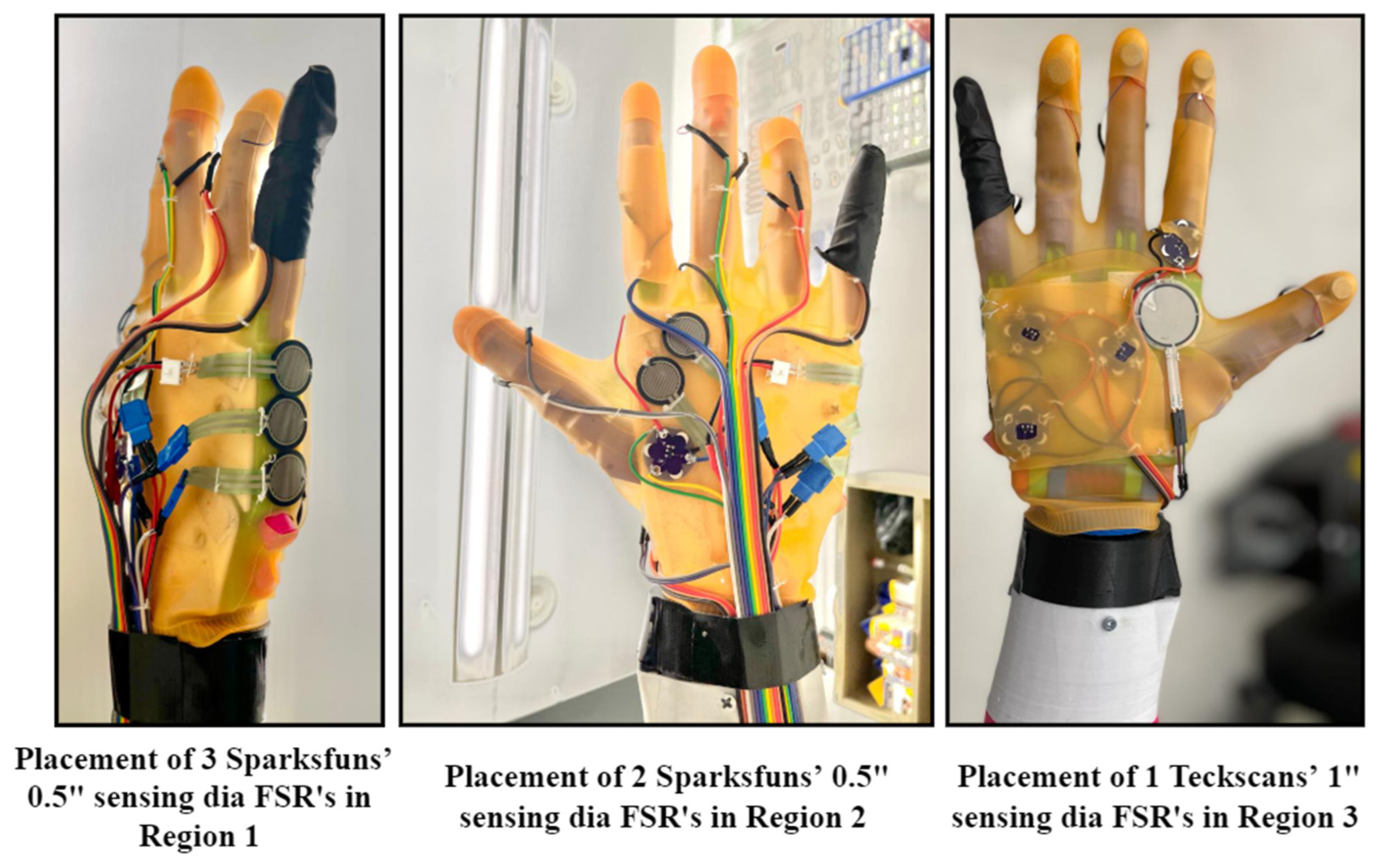

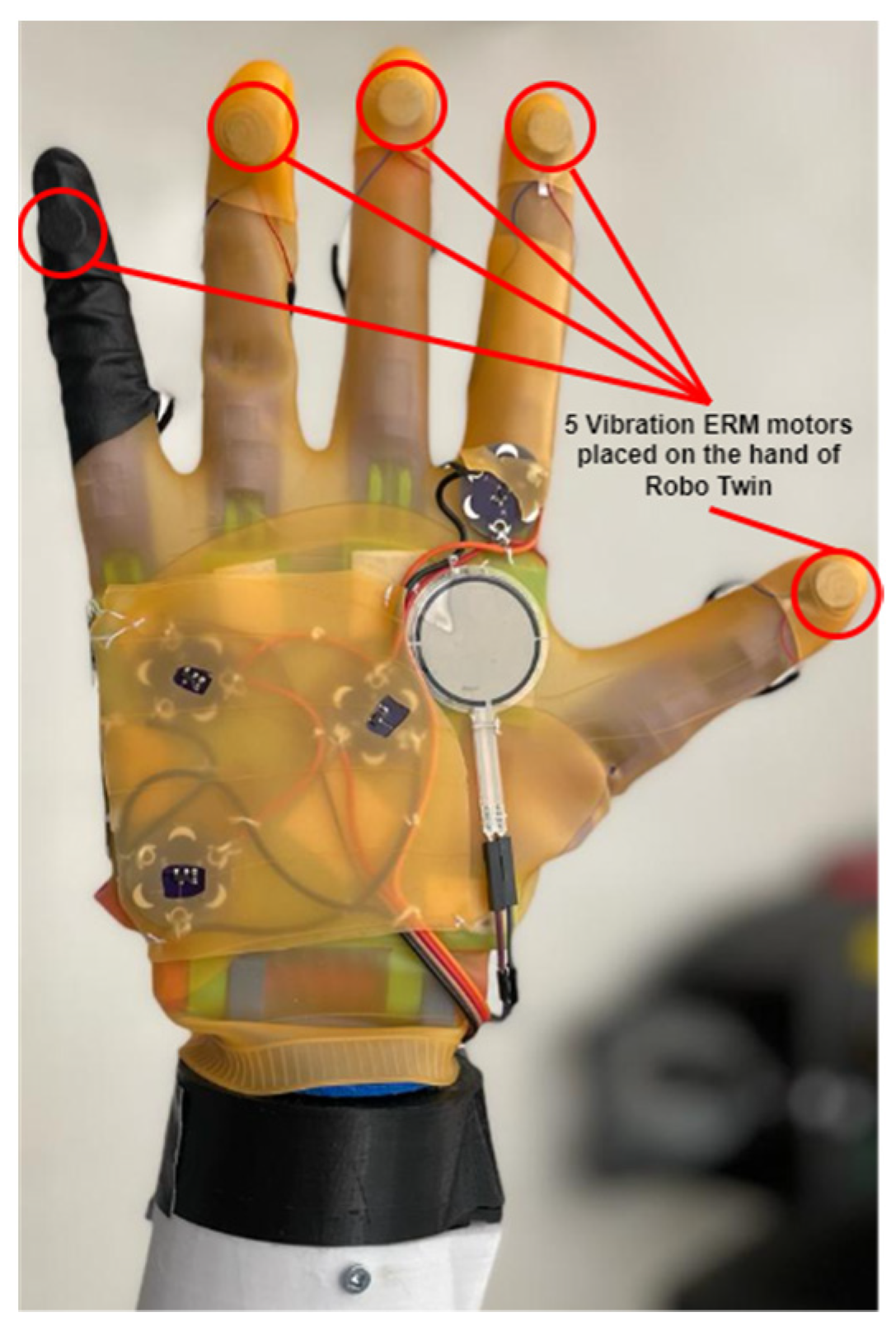
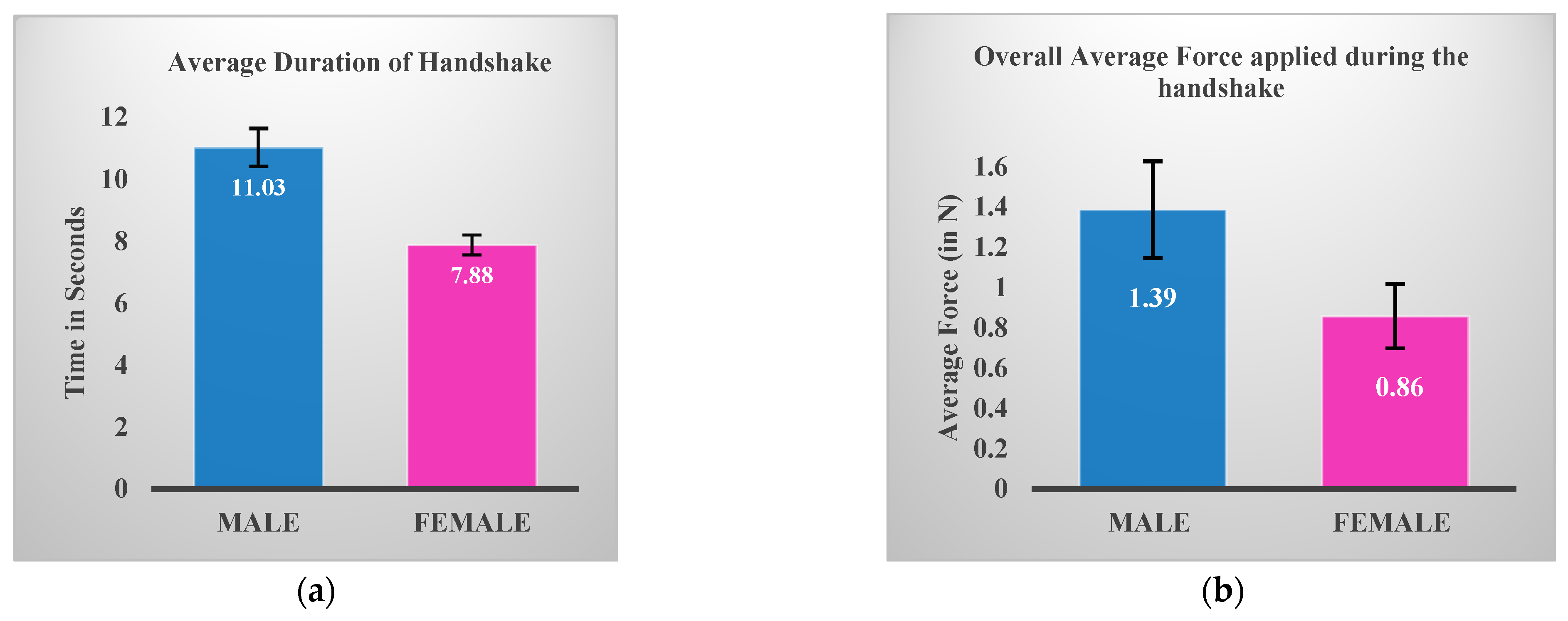
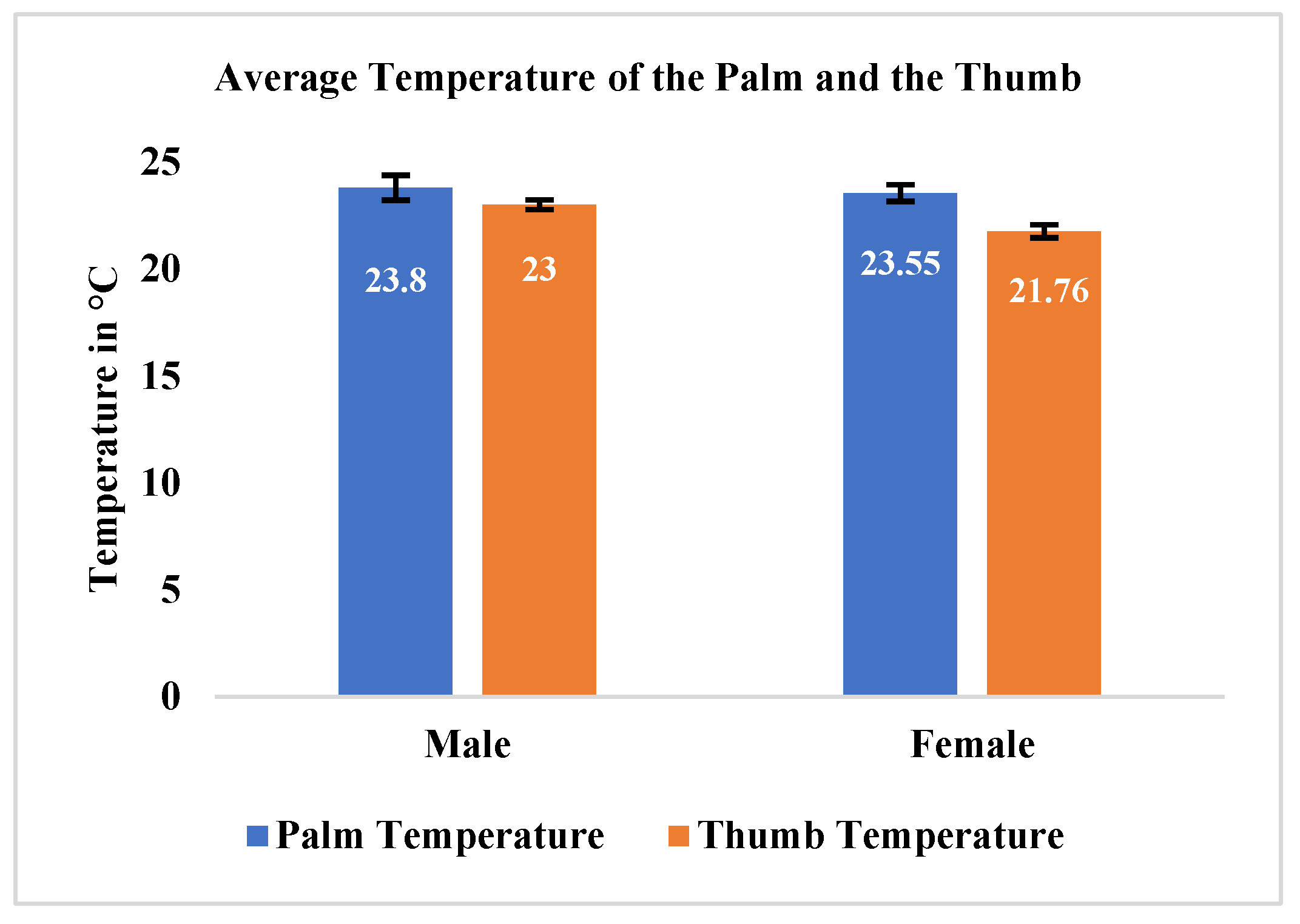
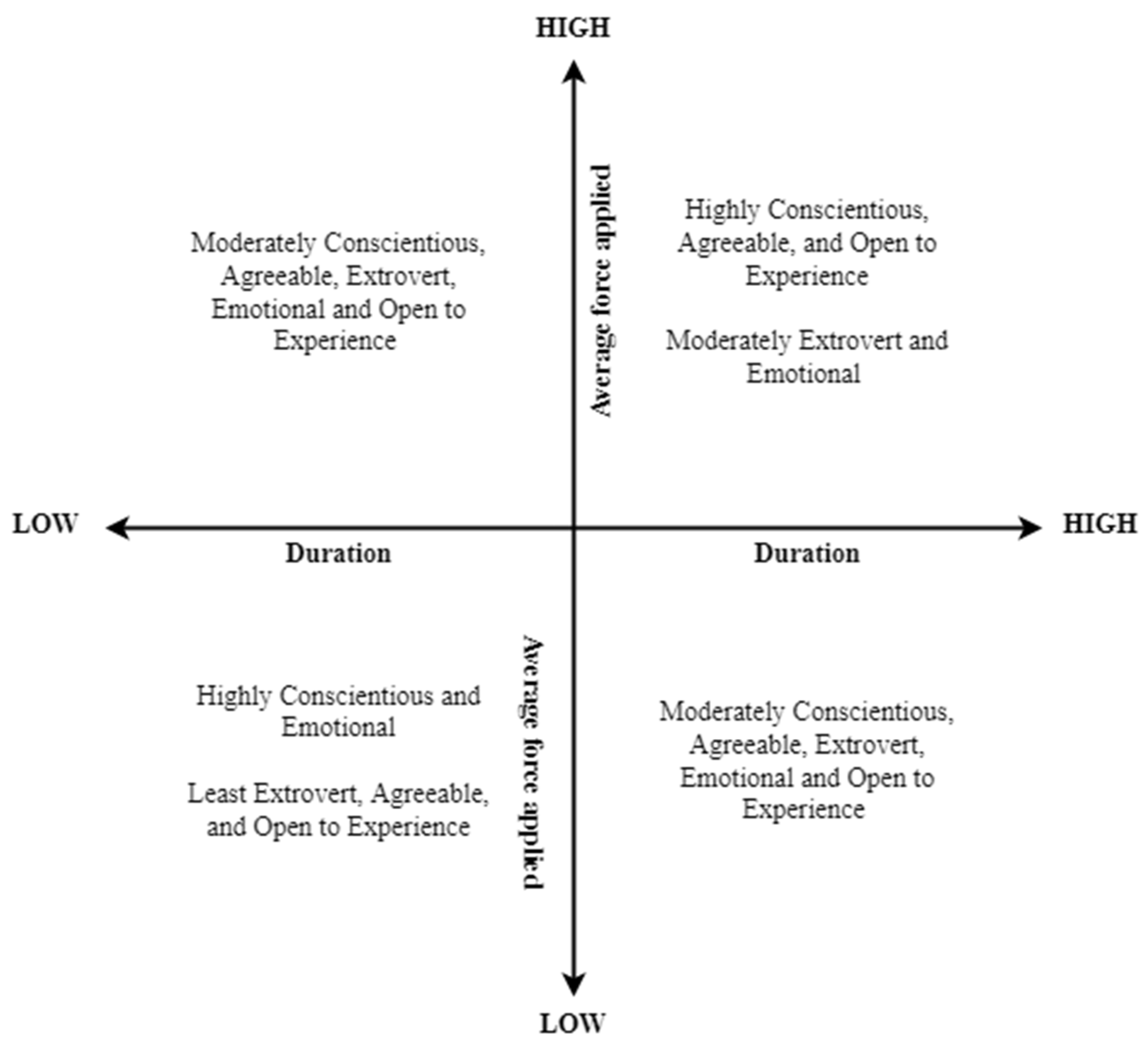
| Dataset | Correlation Coefficient ‘r’ |
|---|---|
| Applied force and FSR’s output resistance | −0.5179 |
| Applied force and FSR’s output conductance | 0.9906 |
| Range | Estimated Line of Regression |
|---|---|
| (0 to 120) µMho | Applied Force (in N) = 0.00473 × Conductance (in µMoh) + 0.0347 |
| (121 to 250) µMho | Applied Force (in N) = 0.00889 × Conductance (in µMoh) − 0.4670 |
| (251 to 600) µMho | Applied Force (in N) = 0.01273 × Conductance (in µMoh) − 1.5289 |
| (>600) µMho | Applied Force (in N) = 0.01613 × Conductance (in µMoh) − 3.4949 |
| Standard Weight (grams) | Equivalent Force (N) | Calibration Result (N) |
|---|---|---|
| 0 | 0 | 0 |
| 50 | 0.49 | 0.50 |
| 100 | 0.98 | 0.96 |
Disclaimer/Publisher’s Note: The statements, opinions and data contained in all publications are solely those of the individual author(s) and contributor(s) and not of MDPI and/or the editor(s). MDPI and/or the editor(s) disclaim responsibility for any injury to people or property resulting from any ideas, methods, instructions or products referred to in the content. |
© 2023 by the authors. Licensee MDPI, Basel, Switzerland. This article is an open access article distributed under the terms and conditions of the Creative Commons Attribution (CC BY) license (https://creativecommons.org/licenses/by/4.0/).
Share and Cite
Faisal, M.; Laamarti, F.; El Saddik, A. Digital Twin Haptic Robotic Arms: Towards Handshakes in the Metaverse. Electronics 2023, 12, 2603. https://doi.org/10.3390/electronics12122603
Faisal M, Laamarti F, El Saddik A. Digital Twin Haptic Robotic Arms: Towards Handshakes in the Metaverse. Electronics. 2023; 12(12):2603. https://doi.org/10.3390/electronics12122603
Chicago/Turabian StyleFaisal, Mohd, Fedwa Laamarti, and Abdulmotaleb El Saddik. 2023. "Digital Twin Haptic Robotic Arms: Towards Handshakes in the Metaverse" Electronics 12, no. 12: 2603. https://doi.org/10.3390/electronics12122603








